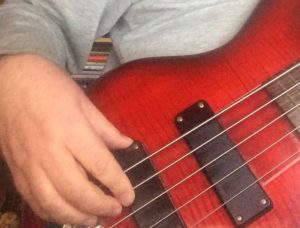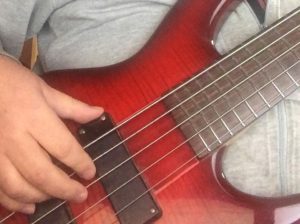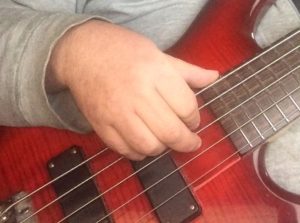Mark Nisbet
All about Mark Nisbet and his music
Your Hands
Now to put all these things together and play the instrument. So plug the lead into the bass and then into the amp, turn on the amp (making sure the volume is nice and low initially or you have plugged in some headphones). Put the strap over your shoulder and let us consider what you are going to do with your hands. This may seem obvious but it is worth looking at in some detail to help you gain the best possible technique from the beginning. I have titled these as for right-handed players so if you are left-handed the roles of each haand will be reversed.
The Right or Plucking hand
So the point of the right hand is to make the strings vibrate. This can be done using any of the fingers on the right hand or by using a plectrum (or pic). You should explore all these options but to start with we can consider the index and middle fingers. To use these fingers effectively the first thing you need to consider is where to rest your thumb. Later you may use your thumb to help mute strings that you are not playing but for now you need to rest it somewhere just above the strings. Some basses have a thumb rest ready to use but often the best place to rest your thumb is either at the top of a pickup or possibly on the top of the fret board where it overlaps the body. These positions should allow your fingers to rest comfortably on the strings. It actually doesn’t matter at this stage whereabouts along the length of the strings between the neck and the bridge you are although this is one of the things that will effect the tone of the sound you create.
 |
 |
 |
With your thumb comfortable place your index finger just under the string, as in towards the ground, not between the string and the guitar body, and then pull the finger towards you so that it pulls the string and slides over the top making the string vibrate. very importantly you should then touch your finger back on the string which will stop it vibrating and therefore end the note you have played.
The Left or Fretting hand
The role of the fretting hand is mainly to change the note being played. If this hand is kept away from the strings then the string will vibrate for its whole length and is said to be open. To change the note a finger is placed onto the fingerboard just behind a fret. The palm of your hand will be behind the neck with your fingers wrapped around underneath. Your thumb is best placed directly behind the finger that is fretting the note. That way you are effectively squeezing the string and the neck between thumb and finger. If yu push too gently the string will sound dull or possibly buzz on the fret. This will not be easy to start with and that is where practice comes in as your hands will need to physically change to make this easy but if you keep at it this will not take too long.
Aches and pains
Learning any instrument requires physical changes to your body and the only way to achieve this is practice. You will suffer some soreness and possibly blisters on your fingers and some muscles will ache a bit. There should never be any severe pain however and if there is there is something badly wrong with your technique and you need to change it before lasting damage is done.